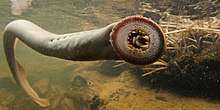Pacific lamprey
The Pacific lamprey (Entosphenus tridentatus) is an anadromous parasitic lamprey from the Pacific Coast of North America and Asia. It is a member of the Petromyzontidae family. The Pacific lamprey is also known as the three-tooth lamprey and tridentate lamprey.
| Pacific lamprey | |
|---|---|
 | |
| Scientific classification | |
| Kingdom: | |
| Phylum: | |
| Class: | |
| Order: | |
| Family: | |
| Genus: | |
| Species: | E. tridentatus |
| Binomial name | |
| Entosphenus tridentatus (Richardson, 1836) | |
| Synonyms[1][2] | |
| |

Description
.jpg)
Pacific lampreys grow to about 80 cm (31 in) as adults. They are anadromous and semelparous. They have slender, elongated bodies with two dorsal fins arising far back on the body. The anal fins are rudimentary and the lower lobe of the caudal fin is larger than the upper lobe and both lobes are continuous with the dorsal fin and the anal fin. Adults living in the sea are a bluish-black or greenish colour above and pale below, but those in fresh water are brown. This species is distinguished by having three (or occasionally two) sharp teeth on the supraoral bar above the mouth and three sharp points on each lateral plate.[3]
Biology
Although the adult and juvenile stages are more noticeable, lampreys spend the majority of their lives as larvae (ammocoetes). Ammocoetes live in fresh water for many years (usually 3–7 years, but at least one species has been recorded for +17 years). Ammocoetes are filter feeders that draw overlying water into burrows they dig into soft bottom substrates. After the larval period, the ammocoetes undergo metamorphosis and take on the juvenile/adult body morphology. Juveniles/adults have a jawless, sucker-like mouth that allows them to become parasitic on other fish and sperm whales, attaching themselves with their suckers and feeding on blood and body fluids. The adults live at least one to two years in the ocean and then return to fresh water to spawn. Whether Pacific lampreys return to their natal streams or seek spawning areas based on other cues is not known. They typically spawn in similar habitat to Pacific salmon and trout. Lampreys construct a nest (redd) in small gravel and females can lay over 100,000 eggs, which are fertilized externally by the male. After spawning, the adults usually die within four days. Also, like salmon, the Pacific lamprey does not feed while migrating to spawn.[3]
As food
Pacific lampreys are an important ceremonial food for Native American tribes in the Columbia River basin and the Yurok people of the Klamath River Wiyot people of the Eel River in northern California.[4] Pacific lamprey numbers in the Columbia River have greatly declined with the construction of the Columbia River hydropower system. Almost no harvest opportunity for Native Americans remains in the Columbia River and its tributaries except for a small annual harvest at Willamette Falls on the Willamette River (tributary to the Columbia River). The Yurok and Wiyot snag lampreys in the surf at the mouth of the Klamath River, often at night, using hand-carved wooden "hooks". It is dangerous work.[4]
References
- Van Der Laan, Richard; Eschmeyer, William N.; Fricke, Ronald (11 November 2014). "Family-group names of Recent fishes". Zootaxa. 3882 (1): 1–230. doi:10.11646/zootaxa.3882.1.1. PMID 25543675.
- Froese, R.; Pauly, D. (2017). "Petromyzontidae". FishBase version (02/2017). Retrieved 18 May 2017.
- Froese, Rainer and Pauly, Daniel, eds. (2012). "Entosphenus tridentatus" in FishBase. April 2012 version.
- Patricia Leigh Brown (April 15, 2015). "Hooking a Slippery Prize Where the Klamath River Meets the Pacific". The New York Times. Retrieved April 15, 2015.